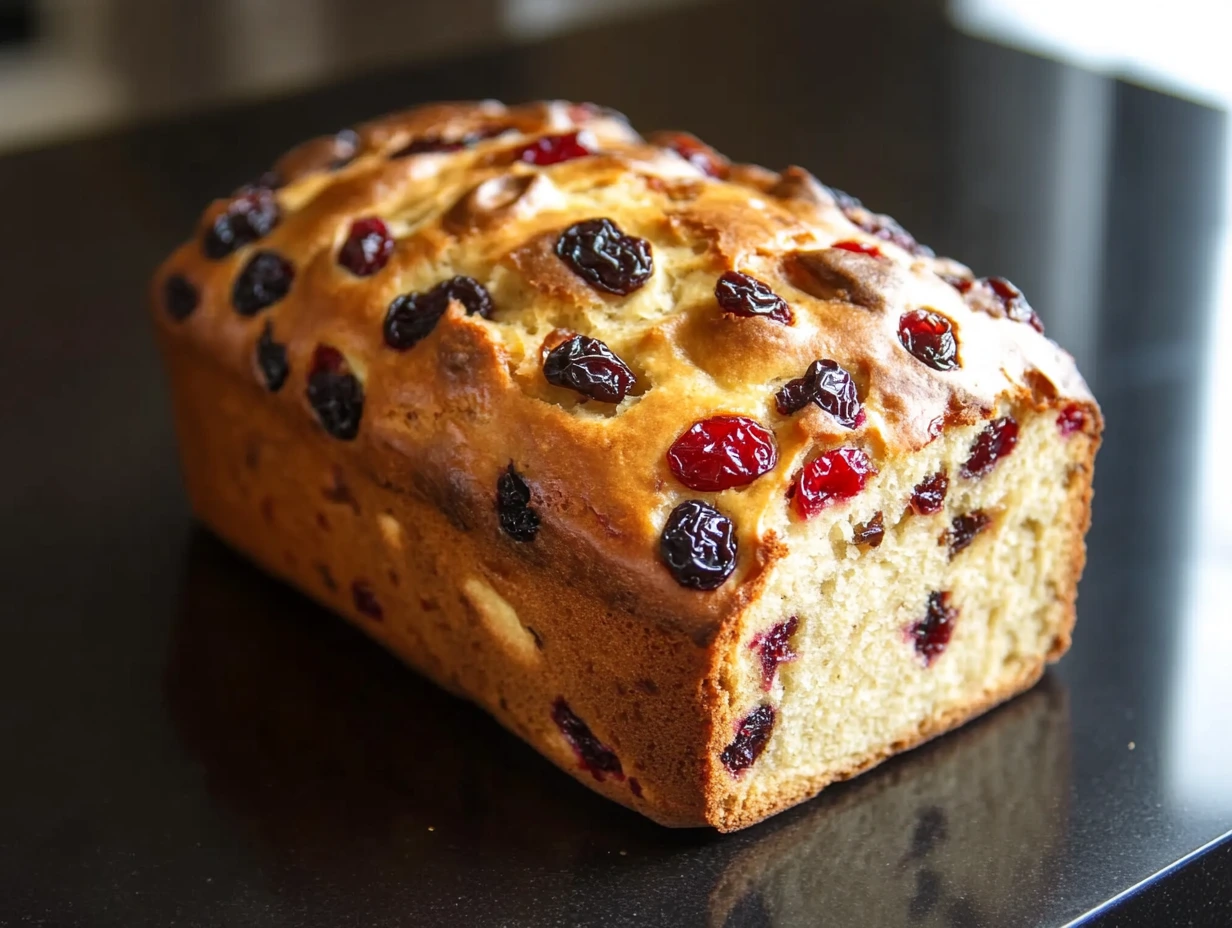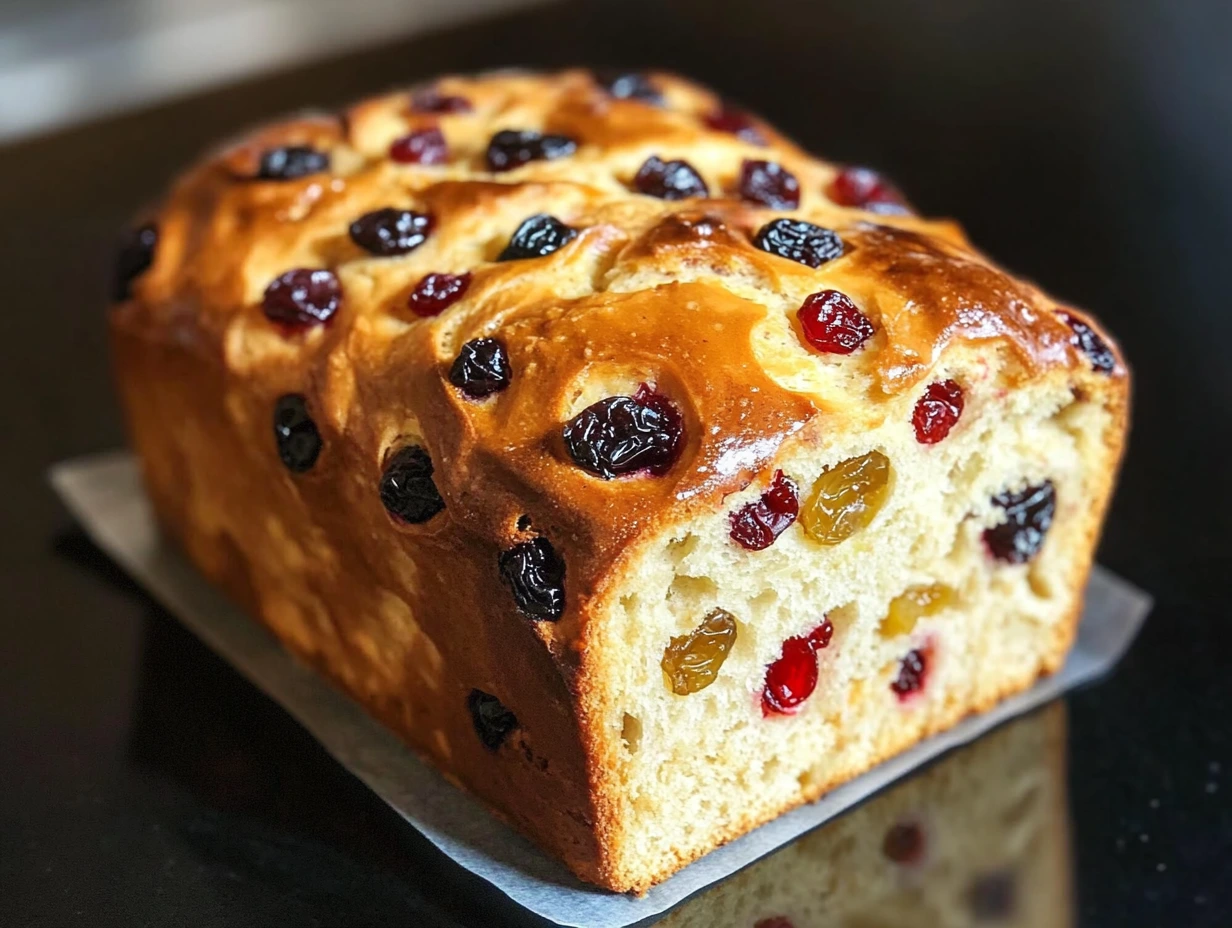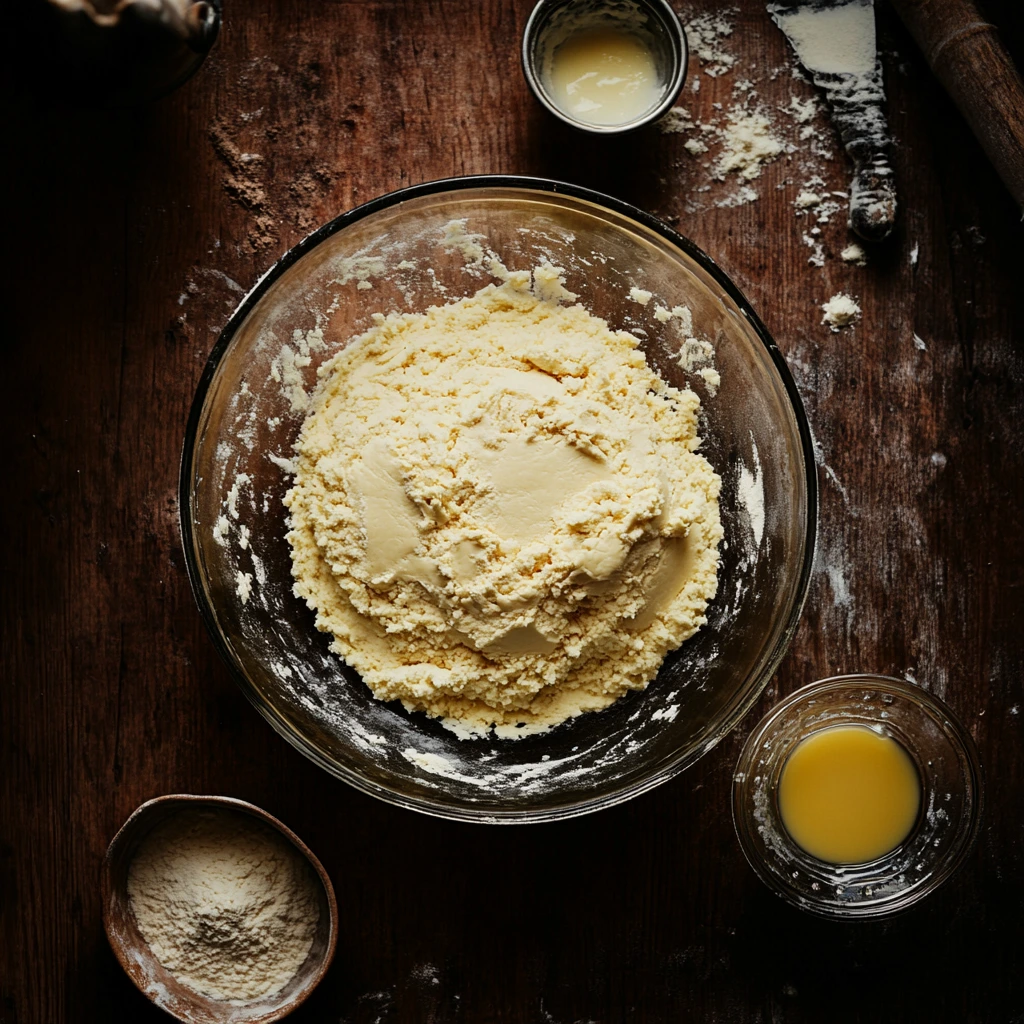There’s something magical about the smell of fresh-baked bread wafting through your home, isn’t there? For me, it brings a wave of nostalgia, a sense of calm, and most importantly, the promise of a delicious treat. Today, I’m sharing a recipe that’s not only a joy to bake but also a feast for the senses—Homemade Fruit Bread. Packed with dried fruits and warm spices, this loaf is the perfect blend of sweet and subtly spiced, making it an excellent choice for breakfast, tea time, or a cozy snack by the fire.
Let’s get started with the first steps in creating this delightful bread. Don’t worry—if you’re a novice baker, this recipe is approachable and forgiving, so you’re in for a win!
Ingredients You’ll Need
To make this fruit bread, we’ll divide the ingredients into two parts: the dough and the fruit mix. Here’s what you’ll need:
For the Dough:
- Flour: 357 g (or 2 ¾ cups, loosely packed)
- Warm water: 210 ml (1 cup minus 2 tbsp)
- Instant yeast: 1 tsp (or 1 ¼ tsp active dry yeast)
- Salt: 1 tsp (5.9 g)
- Butter: 42.6 g (3 tbsp, melted)
- Sugar: 32 g (2 ½ tbsp, or adjust to taste)
For the Fruit Mix:
- Dried cranberries: 80–90 g (~½ cup)
- Raisins: 80–90 g (~½ cup)
- Currants: 60–70 g (~½ cup)
- Dried cherries (optional): 80–90 g (~½ cup)
- Spices: ½ tsp cinnamon powder, ¼ tsp cardamom powder, and ¼ tsp nutmeg powder (optional)
- Vanilla sugar or pure vanilla extract: ½ tsp
Step 1: Preparing the Dough
Start by gathering a large mixing bowl and your ingredients for the dough. In the bowl, combine the warm water, sugar, salt, and yeast, stirring until everything dissolves. I like to let this mixture sit for a minute or two—it’s a little reassuring to see the yeast bubbling, knowing it’s alive and ready to work its magic!
Next, add the melted butter to the bowl and stir it in well. Gradually mix in the flour, a little at a time, until you can’t see any dry patches. At this point, the dough will come together into a shaggy mass, and that’s exactly what we want. Don’t overmix here—it’s perfectly fine if it looks a bit rough.
Step 2: First Proofing
Once your dough is mixed, it’s time for the first proofing. Cover the bowl tightly with plastic wrap or a clean kitchen towel and place it in a warm spot. A little tip: if your kitchen is chilly, set the bowl near a warm oven or even on top of the fridge—it’s amazing how much warmth that spot can hold!
Let the dough rest for about an hour, or until it has doubled in size. If it’s cooler in your home, you might need to give it up to 1 ½ hours. Use this time to prepare your fruit mix, which is where the real personality of this bread comes through.
Step 3: Infusing the Fruit Mix
In a separate bowl, combine all the dried fruits—cranberries, raisins, currants, and cherries if you’re using them. Sprinkle in the cinnamon, cardamom, and nutmeg for that warm, cozy flavor. Finally, add a dash of vanilla sugar or a few drops of pure vanilla extract to bring it all together. Toss everything gently to coat the fruit evenly in the spices.
The fruit mix is now ready to be folded into your dough once it’s done proofing. Trust me, the combination of these fruits and spices will make your bread irresistible
Shaping, Proofing, and Baking Your Fruit Bread
Welcome back! Now that we’ve prepared the dough and infused the fruit mix with warm, aromatic spices, it’s time to bring everything together. This next part is where the magic really starts to happen—the dough transforms into a beautiful, fruit-studded loaf that’s just begging to be baked.
Step 4: Incorporating the Fruit Mix and Shaping the Dough
Once your dough has doubled in size, it’s time to fold in the fruit mix. This part is so satisfying!
Start by gently deflating the dough—don’t worry, this won’t hurt it. Turn it out onto a clean surface lightly dusted with flour. Spread the dough out with your hands into a rough rectangle, about ½-inch thick. Sprinkle the fruit mix evenly over the surface, pressing it gently into the dough.
Now, fold the edges of the dough inward, almost like you’re wrapping the fruit in a cozy blanket. Knead the dough lightly to distribute the fruit evenly. Be gentle—you want the fruit to stay intact and not burst. If the dough gets a bit sticky, sprinkle a little extra flour, but don’t overdo it.
Next, shape the dough into a log or oval. If you’re like me and love that classic loaf shape, roll the dough up jelly-roll style. Tuck the edges under to create a smooth top, then place the dough seam-side down into a greased loaf pan.
Step 5: Second Proofing
This is the part where patience pays off. Cover the pan with cling film or a clean kitchen towel and set it in a warm spot again. Allow the dough to rise for about 90 minutes.
During this time, the dough will puff up beautifully, filling the pan. If you’re anything like me, this is when the excitement starts to build—because you know you’re one step closer to that heavenly aroma filling your kitchen!
Step 6: Prepping for Baking
After the second proofing, your dough should be well-risen and ready for the oven. For a glossy, golden finish, brush the top of the loaf with a light egg wash (one beaten egg with a splash of milk or water).
Here’s a tip: If you want a little extra texture and flavor, you can sprinkle the top with a dusting of cinnamon sugar or a handful of slivered almonds. It adds a nice finishing touch that’s sure to impress!
Step 7: Baking Your Fruit Bread
It’s time to bake! Preheat your oven to 350°F (180°C). Place the loaf on the middle rack and let it bake for 34–35 minutes.
After this initial bake, reduce the oven temperature to 325°F (165°C) and continue baking for another 4–5 minutes. Keep an eye on the loaf—if the top starts to brown too quickly, tent it loosely with aluminum foil.
You’ll know the bread is done when the top is golden and it sounds hollow when tapped on the bottom. If you’re unsure, you can use an instant-read thermometer—the internal temperature should be around 190°F (88°C) for perfect doneness.

Step 8: Cooling the Bread
As tempting as it is to slice into your freshly baked loaf right away, cooling is a crucial step. Allow the bread to sit in the pan for 2–3 minutes before transferring it to a wire rack.
Let it cool completely—yes, completely! This can take about 2–3 hours, and while it feels like a lifetime, trust me, it’s worth the wait. Cutting into warm bread can cause it to become gummy, so patience is your best friend here.
Helpful Tips for a Perfect Loaf
- Room Temperature Proofing: If your home is particularly chilly, consider placing the loaf near a sunny window or in an oven that’s been slightly warmed and then turned off.
- Fruit Distribution: If some fruit pokes out of the dough, gently push it back in or cover it with a bit of extra dough. Exposed fruit can scorch during baking.
- Don’t Skip Cooling: This step ensures your bread slices cleanly and has the best texture.
FAQ Section: Your Questions Answered
1. Can I use fresh fruit instead of dried fruit?
Fresh fruit has a much higher water content, which can affect the dough’s texture and baking time. Stick to dried fruit for the best results. If you want to experiment with fresh fruit, reduce the water in the dough slightly and expect a softer, denser loaf.
2. What can I use if I don’t have all the spices?
No problem! You can use a pre-made pumpkin spice blend or even just cinnamon on its own. The spices are there to enhance the flavor, so feel free to adjust to your taste.
3. My dough isn’t rising—what went wrong?
There are a few culprits: the yeast could be expired, the water may have been too hot or too cold, or the room temperature may have been too low. Make sure your yeast is fresh, the water is warm (not hot), and your dough is proofing in a cozy spot.
4. Can I make this bread gluten-free?
Yes, but you’ll need a gluten-free flour blend specifically designed for yeast breads. Keep in mind, the texture might be different from the traditional version.
5. How should I store this fruit bread?
Wrap the loaf tightly in plastic wrap or store it in an airtight container at room temperature for up to three days. For longer storage, slice the bread, wrap it in plastic, and freeze. Thaw slices at room temperature or toast them for a quick treat.
6. Can I add nuts to the bread?
Absolutely! Chopped walnuts, pecans, or even almonds make a fantastic addition. Just fold them into the dough along with the fruit mix.
7. How can I tell if my bread is fully baked?
The bread is done when it’s golden brown and sounds hollow when tapped on the bottom. For extra assurance, use an instant-read thermometer—the internal temperature should reach 190°F (88°C).
Conclusion: A Bread Worth Sharing
Congratulations! You’ve just created a homemade fruit bread that’s as delightful to make as it is to eat. The combination of soft, fluffy dough with bursts of sweet, spiced fruit makes this loaf a standout treat, perfect for any occasion.
Whether you’re enjoying it as part of a cozy breakfast, serving it as a mid-afternoon snack, or gifting it to loved ones, this bread is sure to impress. And the best part? It’s versatile! Try it toasted with a smear of butter, or get creative by making a sweet bread pudding or French toast with the leftovers.
Print
Fruit Bread
- Author: Christophe
Description
This fruit bread recipe produces a soft, flavorful loaf loaded with dried fruits and warm spices. Perfect for breakfast, a snack, or even a festive treat! The blend of raisins, cranberries, currants, and cherries creates a delightful sweetness, balanced by a touch of cinnamon and cardamom.
Ingredients
For the Dough:
357 g Flour (or 2 3/4 cups, loosely packed)
210 ml Warm water (1 cup minus 2 tbsp)
1 tsp Instant yeast (1 1/4 tsp active dry yeast)
1 tsp Salt (5.9 g)
42.6 g Butter (3 tbsp, melted)
32 g Sugar (2 1/2 tbsp or more, as preferred)
For the Fruit Mix:
80–90 g Cranberries (~1/2 cup)
80–90 g Raisins (~1/2 cup)
60–70 g Currants (~1/2 cup)
80–90 g Dried whole cherries (optional, ~1/2 cup)
1/2 tsp Cinnamon powder
1/4 tsp Cardamom powder
1/4 tsp Nutmeg powder (optional)
1/2 tsp Vanilla sugar or pure vanilla extract
Instructions
1️⃣ Prepare the Dough
In a large bowl, combine warm water, sugar, salt, and yeast. Stir until dissolved.
Add melted butter and mix well.
Gradually add flour, stirring until no dry patches remain. The dough should form a shaggy mass.
2️⃣ First Proofing
Cover the bowl with plastic wrap and let the dough rise in a warm environment for about 1 hour, or until nearly doubled in size.
If the room is cool, allow 1 1/2 hours for proofing.
3️⃣ Shape the Dough
Once risen, incorporate the fruit mix into the dough by folding it in gently to avoid overworking.
Flatten the dough into a rectangle, roll it up jelly-roll style, and place it seam-side down into a greased loaf pan.
Cover with cling film and let it rest for another 90 minutes in a warm environment.
4️⃣ Final Proofing
After 90 minutes, the dough should be well-risen. Brush the top with a light egg wash (optional) for a glossy finish.
5️⃣ Bake the Bread
Preheat your oven to 350°F (180°C). Bake the loaf for 34–35 minutes.
Lower the temperature to 325°F (165°C) and bake for an additional 4–5 minutes.
If the top browns too quickly, tent it with aluminum foil after 25 minutes.
6️⃣ Cool the Bread
Let the loaf sit in the baking pan for 2–3 minutes.
Remove it from the pan and allow it to cool completely on a wire rack for 2–3 hours before slicing.
Notes
- For softer crust, brush the warm loaf with butter immediately after baking.
- Letting the bread cool completely ensures the residual heat fully bakes the interior, preventing a doughy center.
- Thick slices are perfect for French toast or toasted with butter.












